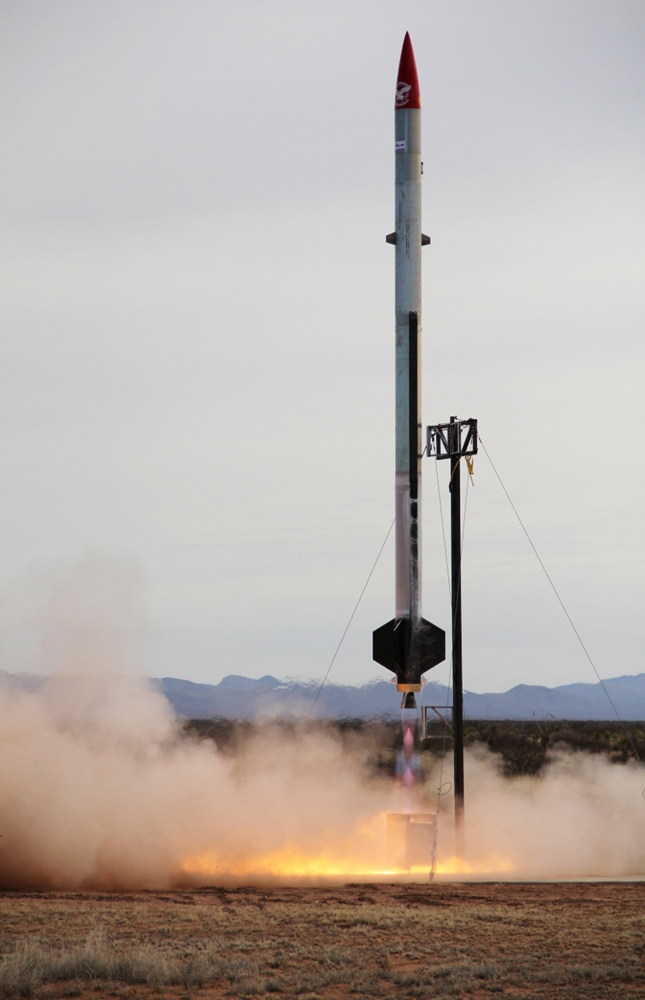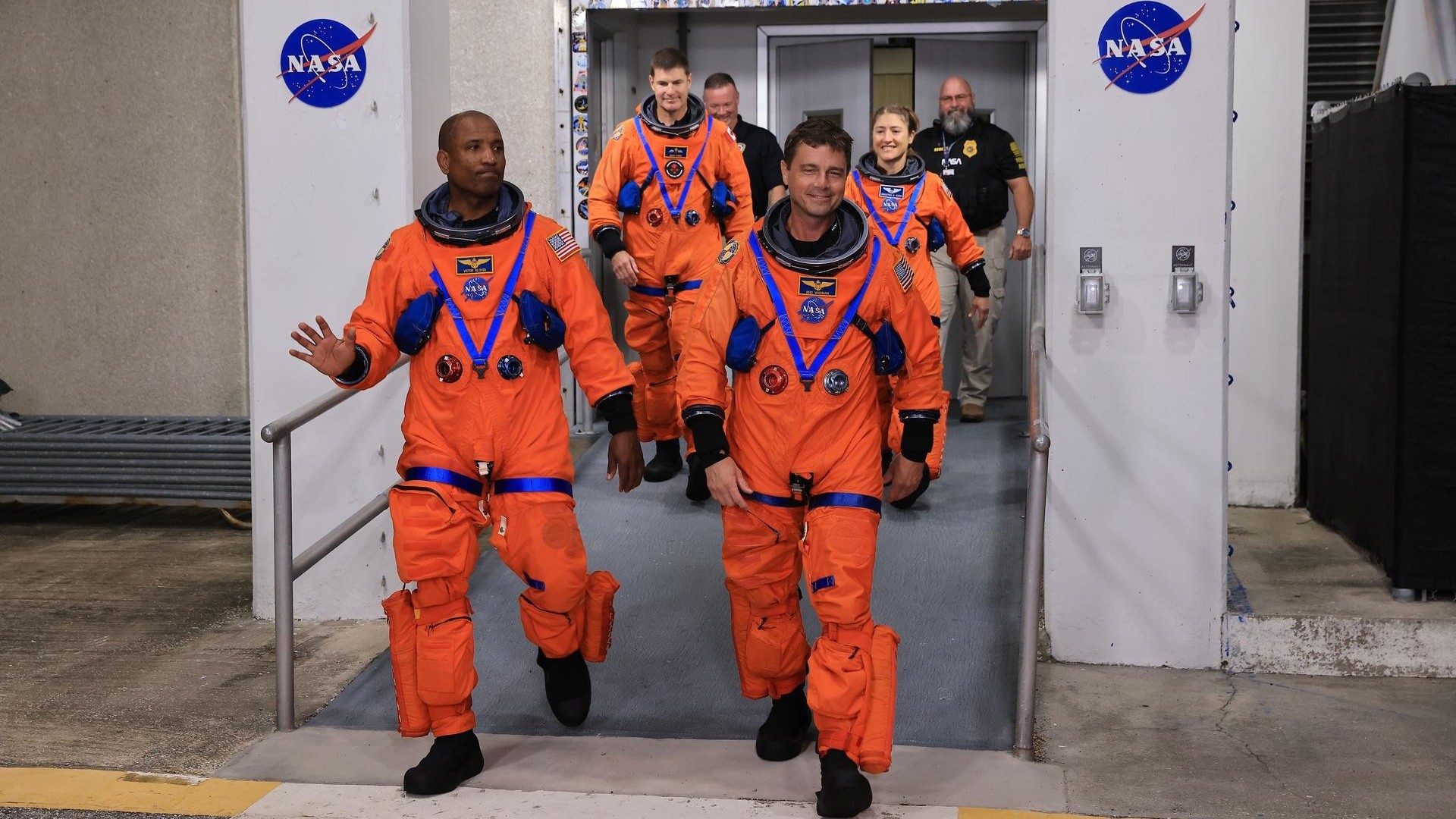
Private Rocket Launch Tests Supersonic Parachute, Reusable Spaceship Tech

The private spaceflight company Armadillo Aerospace is taking a close look at the results from its latest rocket test in the New Mexico desert — a flight that hit a snag while testing a new launch and balloon parachute technologies.
The Heath, Texas-based company founded by computer game developer John Carmack launched the slender unmanned rocket to an altitude of about 50 miles (82 kilometers) during the Jan. 28 test from New Mexico's Spaceport America.
One of the technologies riding on the rocket included a novel supersonic balloon parachute — known as a ballute — which appeared to deploy in photos, but failed to operate as planned. The rocket's body, nose cone and ballute subsequently fell back to Earth to make a "hard landing," officials said.
But despite the ballute failure, Armadillo Aerospace officials said the STIG A-3 rocket launch accomplished its primary mission, which was to determine the booster's maximum performance capability to test several modifications that had been made since an earlier December flight of the same vehicle.
"The STIG A-3 mission was the next incremental step in the development of a truly reusable suborbital spacecraft," said Neil Milburn, Armadillo's vice president of program management. "As such, the supersonic ballute-drogue was just one facet of this complex vehicle that was being tested at Spaceport America."
The rocket body, nose cone and ballute were all recovered on Spaceport America property, Armadillo officials said in a Feb. 1 statement. [SPACE.com's Photo Tour of Spaceport America]
The mission was the third launch test of Armadillo's STIG-A reusable suborbital rocket design from Spaceport America's vertical launch complex. The test flight was not publicly announced in advance, or open to public observers.
Breaking space news, the latest updates on rocket launches, skywatching events and more!
In addition to vertical launches, Spaceport America is the home port of Virgin Galactic, a company that is building private spaceships to launch passengers on suborbital spaceflights. Suborbital spaceflights are launches that can the edge of space or beyond, but do not have the speed or re-entry shielding necessary to sustain full orbital spaceflight.

Telemetry and video being analyzed
Rocketeers at Armadillo Aerospace are analyzing data from the flight.
"We're working through the telemetry and video … and should have some detailed information to release in a couple of days," Milburn said.
The failure of STIG A-3's ballute recovery system meant that the vehicle's Global Positioning System driven steerable main parachute could not be deployed as intended, Armadillo officials stated. The rocket used in the STIG A-3 flight test was the same vehicle that flew in December 2011 and successfully demonstrated the feasibility of a reusable rocket, they added.
"The altitude achieved in this second flight was approximately twice that of the earlier flight and again tested many of the core technologies needed for the proposed manned reusable suborbital vehicle," Armadillo officials explained in a statement.
Based on the results of this flight Armadillo officials are now busy building the successor vehicle, STIG B, which will incorporate the lessons learned from the STIG A series and also be space capable, Milburn explained.

Next incremental step
"We consider the STIG A series to have been a very successful program in the true Armadillo Aerospace tradition of learning by flying. Armadillo Aerospace has more rocket powered flights to its credit than the rest of the AltSpace industry combined and we intend to continue in that vein in the future," he added.
The next step for Armadillo Aerospace will be launching the STIG B rocket to up to an altitude of 62 miles (100 km). That flight is currently slated to launch from Spaceport America in early spring.
Armadillo Aerospace has partnered with the Virginia-based space tourism company Space Adventures to develop a private spacecraft capable of flying passengers on suborbital flights for about $102,000 a seat.
Spaceport America taking off
With more flights planned, Spaceport America continues to be a work in progress, said Christine Anderson, executive director of the New Mexico Spaceport Authority. While the sprawling complex will support Virgin Galactic's commercial suborbital spaceflights, other potential users are eyeing the spaceport's launch facilities.
"We are very busy finishing up Phase 1 of the spaceport build-out, which includes the Virgin Galactic terminal hangar facility, now appropriately called the VG Gateway to Space," Anderson told SPACE.com. "We are completing our office and operational facility, the Spaceport Operations Center, and completing Phase 1 internal roads. All functional facilities like water system, fuel storage and wastewater are complete. We are also well into the development of another road linking the southern part of New Mexico to the spaceport for those coming from the Las Cruces and El Paso areas."
Anderson said that work on Phase 2 is well under way, which includes further build-out of the vertical launch area.
"We are extending utilities to this area and we recently received a Federal Aviation Administration grant for a larger vertical launch pad and vertical launch structure. We are also putting in two facilities in the vertical launch areas for payload integration and launch operations," Anderson said.

More rocket launches planned
The new launch pad will measure 150 feet by 50 feet (about 46 by 15 meters), Anderson said.
The pad will be equipped with a 60 foot by 30 foot (18 by 9 m) vehicle integration shelter with an opening that is about 25 feet (7.6 m) wide and tall. It will be mounted on rails so that it can be rolled back for launch.
The actual rocket launcher will be supplied by the customer using the facility at any given time, Anderson explained, adding that customers will have to assemble their vehicles and place them on their launchers in the horizontal orientation inside the shelter structure.
Prior to launch, the shelter will be rolled back and the vehicle hoisted into launch position. Anderson said the shelter will be large enough to accommodate a launch vehicle and the launcher with work space on all sides.
Armadillo Aerospace's Jan. 28 test flight marked the 14th launch from the Spaceport America vertical launch complex since 2006.
"We see a definite uptick in vertical launch activity," Anderson said, adding that the spaceport can now accommodate tourists with special hard-hat tours of the facility. "Visitors are welcome now even though we are not officially open."
Leonard David has been reporting on the space industry for more than five decades. He is a winner of last year's National Space Club Press Award and a past editor-in-chief of the National Space Society's Ad Astra and Space World magazines. He has written for SPACE.com since 1999.
Join our Space Forums to keep talking space on the latest missions, night sky and more! And if you have a news tip, correction or comment, let us know at: community@space.com.

Leonard David is an award-winning space journalist who has been reporting on space activities for more than 50 years. Currently writing as Space.com's Space Insider Columnist among his other projects, Leonard has authored numerous books on space exploration, Mars missions and more, with his latest being "Moon Rush: The New Space Race" published in 2019 by National Geographic. He also wrote "Mars: Our Future on the Red Planet" released in 2016 by National Geographic. Leonard has served as a correspondent for SpaceNews, Scientific American and Aerospace America for the AIAA. He has received many awards, including the first Ordway Award for Sustained Excellence in Spaceflight History in 2015 at the AAS Wernher von Braun Memorial Symposium. You can find out Leonard's latest project at his website and on Twitter.
